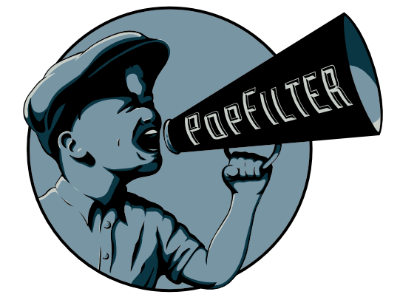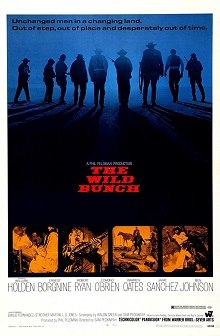Kerri Battles the AFI’s Top 100 — #79: The Wild Bunch
Each week, I try to do as little research or reading up on the film I’m about to watch prior to viewing it because I like to go in with a completely open mind. I usually glance at the runtime and basic credits on IMDb, but that doesn’t often give much away. However, the moment I saw Sam Peckinpah listed as director of The Wild Bunch, I had a pretty good idea of what I was in for this week — a good old fashioned shitkicker western full of blood and gore as far as the eye can see. As expected, Peckinpah did not disappoint.

No, I’m not kidding.
Our tale begins as a group of US Army soldiers ride on horseback into a small south Texas town and head straight to the railroad office. Once inside, it becomes clear that these men are not soldiers at all, but rather a wild bunch of outlaws, led by Pike Bishop, using Army-issue guns to take a railroad fortune. The Bunch are sloppily ambushed by Pike’s former comrade, Deke Thornton, and a group of bounty hunters Thornton repeatedly refers to as gutter trash. A bloody melee ensues and, with the aid of some human shields formerly known as the South Texas Temperance Union, Pike and 4 of his men escape unharmed. Most of the townsfolk don’t fare quite as well. Pike and The Bunch soon discover that the large cache of silver they thought they’d swiped is actually nothing more than steel washers — bait for a poorly laid trap intended to snare the hefty prices on their heads. Pike and The Bunch ride on to a small town in Mexico where one of them, Angel, was born. As they find rest and refuge, Pike and Ernest Borgnine discuss the need to find one last great score to retire. They also discover that a General Mapache has been through the town to loot, plunder, murder Angel’s father, and woo away his best girl. When they stumble upon a merry party held by Mapache, Angel spots his ex-girl canoodling with the General and shoots her dead on the spot. In order to make good with the General for the loss of his puta, The Bunch agrees to rob a US train of rifles and ammo on his behalf. In exchange, the General promises to reward them handsomely. Later, Angel requests to give up his share of the promised gold in exchange for one of the cases of rifles. He laments that, if his hometown had been better armed, they may have stood a fighting chance. The heist goes off as planned though, because he knows how Pike’s mind works, Thornton and his men give good chase. Ultimately, the thugs take a swim in the Rio Grande thanks to a shoddy trestle bridge and a little TNT. After The Bunch delivers their booty — in small increments so as not to be double crossed — Mapache informs them that Angel has been ratted out by one of his own and takes him captive as The Bunch escapes. Unfortunately for The Bunch, Thornton and his men continue doggedly in their pursuit. With no where else to turn, they seek refuge back in Mapache’s camp. Upon their return, they find Mapache dragging Angel behind his sweet new car. Pike offers to give back half his share of gold in exchange for Angel, but Mapache decides Angel isn’t worth that much and continues his joy ride. After some rest, reflection, and stinky on their hangdowns on Mapache’s dime, The Bunch decides to make a stand. Meagerly armed, they approach Mapache as he holds court and demand Angel’s return. Mapache agrees and prepares to shove a half-dead Angel into their arms. At the last minute, he pulls out a knife and slits the “traitor’s” throat. Without contemplation, Pike riddles Mapache’s body with bullets. So stunned by this act, none of Mapache’s men immediately react. Borgnine laughs and Pike shoots Mapache’s German advisor in the head. That’s when things get ugly. Bullets and blood fly everywhere until none but a few remain. It’s then that Thornton and his men arrive. Thornton, seeing his corpse dangling from a machine gun, takes Pike’s revolver from the holster and tells his men they’re free to take the bodies back to collect their rewards. He plans to remain.

Thornton lives out the rest of his days with this guy, Sykes, and a bunch of Mexican Guerilla fighters with machetes. … That’s also not a joke.
None of this may sound very original or unique for a Western. Fighting railroad tycoons by blowing up bridges and shooting Mexicans is basically the plot of 50% of the genre. But what makes it all stand out is the fact that these men are a dying breed. The Wild Bunch is set in 1913, when the rest of the world was preparing to go to war with Germany for the first time. Pike Bishop and his men should have been shot or hanged a long time ago, even if they are the best. Unfortunately, they’re so good that they’ve lasted longer than they should — longer than the evolving world around them would like. They ache for one last great score on which to retire because old age isn’t the only thing threatening to put an end to their bandit ways. These are good old fashioned cowboys grasping at what’s left of their lives in a world that is already starting to look at cowboys as relics from days past. The moment that they all decide to stand up to Mapache isn’t just a moment of fraternal love and respect for one of their own. It’s also the moment they all realize that there is no retirement from the firm of Outlaw, Bandit, & Thief. It’s the moment they realize the only way they can go out is in one last great hail of bullets, blood, and glory. They don’t think they can win. Hell, they’re fully prepared to lose. But they know they’re going to take down as many of Mapache’s men as they can in the process. In that, at least, they’re successful. And for all of this, The Wild Bunch becomes far more intriguing than your average root-for-the-outlaw Western.

Who wouldn’t want to watch this mug for two and a half hours?
Also pushing The Wild Bunch ahead of the genre pack is the equally artful and grotesque eye of director Sam Peckinpah. The man’s talent for editing is unparalleled and, in this project, he utilizes quick cuts to create tension and action in ways that would make Darren Aronofsky look like a film school amateur. At the start of the film, just after the railroad office robbery has gone awry, there is a scene of utter chaos and destruction in the center of town. In this moment, Peckinpah chooses to focus on two terrified, blonde, cherubic children who cling to each other as women are trampled and horses are shot all around them. He alternates between long, steady shots of these two innocent faces as they stare in abject horror and rapid fire edits of the violence and carnage that surrounds them. And OH is there carnage. The opening credits include shots of children laughing as a colony of ants eats a scorpion. Then the children light them all on fire. At that point, it becomes readily apparent why Peckinpah is known for his displays of butchery on film. Everything after that moment is just super-fake-blood-and-dismemberment-flavored gravy. Frankly, it’s a refreshing thing to see in a genre that more commonly pretends people don’t really bleed that much after gunfights at high noon.

This is one of the lighter scenes
I probably should have led with this because disclaimers are generally best suited at the start. Still, you should know that I’m actually a big fan of the Western, so I was a bit biased this week. I was prepared to like this movie. I wasn’t prepared for how much I would like this movie. For 2 weeks running, the AFI and I are on the same page with a pick. I’m afraid to get too comfortable with that. –KSmith

